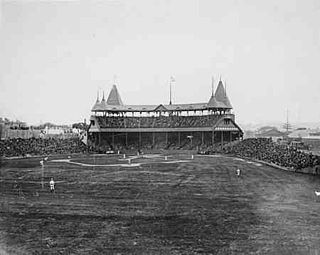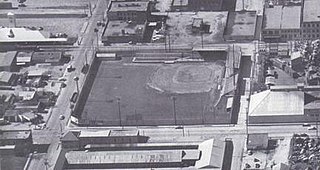
Griffith Stadium stood in Washington, D.C., from 1911 to 1965, between Georgia Avenue and 5th Street, and between W Street and Florida Avenue NW.

Crosley Field was a Major League Baseball park in Cincinnati, Ohio. It was the home field of the National League's Cincinnati Reds from 1912 through June 24, 1970, and the original Cincinnati Bengals football team, members of the second (1937) and third American Football League (1940–41). It was not the original home of the current NFL franchise of the same name: the home of those Bengals in 1968 and 1969 was nearby Nippert Stadium, located on the campus of the University of Cincinnati. Crosley Field was on an asymmetrical block bounded by Findlay Street (south), Western Avenue, Dalton Avenue (east), York Street (north) and McLean Avenue (west) in the Queensgate section of the city. Crosley has the distinction of being the first major-league park with lights for playing night games.

South End Grounds refers to any one of three baseball parks on one site in Boston, Massachusetts. They were home to the franchise that eventually became known as the Boston Braves, first in the National Association and later in the National League, from 1871 to 1914.

UFCU Disch–Falk Field is the baseball stadium of the University of Texas at Austin. It has been home to Texas Longhorns baseball since it opened on February 17, 1975, replacing Clark Field as the home of the Longhorns.

Dell Diamond is the home stadium of the Round Rock Express, the Triple-A Minor League Baseball affiliate of the Texas Rangers major league baseball team. On April 16, 2000, the then-Double-A affiliate Express played their first home game at the stadium.

Pelican Stadium, originally known as Heinemann Park (1915–1937), was a sports stadium in New Orleans, Louisiana from 1915 to 1957.

Vaughn Street Park was a baseball park in the northwest United States, located in Portland, Oregon. Opened in 1901, it lasted for over a half century and was torn down in 1956. Its primary tenant was the Portland Beavers of the Pacific Coast League (PCL). During a stretch when the club was tagged as the "Lucky Beavers", the ballpark was also sometimes called Lucky Beavers Stadium.

Federal League Park or just Federal Park is the name of a former baseball park in Indianapolis, Indiana, United States. The park was home to the Indianapolis Hoosiers of the Federal League in 1914. The park was constructed in 1913 and subsequently demolished in 1916 after the failure of the league.

The Texas Longhorns baseball team represents The University of Texas at Austin in NCAA Division I intercollegiate men's baseball competition. The Longhorns currently compete in the Big 12 Conference.

West End Park was a baseball park in Houston from 1905 to the 1940s. It was the primary ballpark for the city when it was constructed, and the city's first venue for Negro Major League games. From 1909 through 1910 and again in 1915, it also served as the spring training facility of the St. Louis Browns as well as the 1914 New York Yankees of the American League and the 1906 through 1908 St. Louis Cardinals of the National League in Major League Baseball. After its use by its primary tenant, the Houston Buffaloes of the Texas League, the ballpark was sold to what is now known as the Houston Independent School District for its use until it was demolished.

Katy Park was a baseball park located in Waco, Texas and was used by many minor league baseball teams as well as the Baylor Bears for a short time.
Kyle Baseball Field was a baseball venue located in College Station, TX and was approximate to the football stadium, Kyle Field. The ballpark was installed at the same time as the football stadium in 1904; Texas A&M were one of the original members of the Southwest Conference in 1914 but did not begin baseball until 1915.
The Des Moines Boosters were a Western League minor league baseball team based in Des Moines, Iowa, United States that existed from 1908 to 1924. Des Moines fielded teams in the Western League from 1900-1937 and 1947–1958.
Tinker Park is the name of a former baseball ground located in Indianapolis, Indiana. The ground was the primary home of the Indianapolis Hoosiers baseball club of the National League from 1887 to 1889, and also of the Indianapolis Blues of the American Association in 1884.

The 1979 Texas Longhorns baseball team represented the University of Texas at Austin in the 1979 NCAA Division I baseball season. The Longhorns played their home games at Disch–Falk Field. The team was coached by Cliff Gustafson in his 12th season at Texas.

The 1987 Texas Longhorns baseball team represented the University of Texas at Austin in the 1987 NCAA Division I baseball season. The Longhorns played their home games at Disch–Falk Field. The team was coached by Cliff Gustafson in his 20th season at Texas.

The 2022 Texas Longhorns baseball team represents the University of Texas at Austin during the 2022 NCAA Division I baseball season. The Longhorns play their home games at UFCU Disch–Falk Field as a member of the Big 12 Conference. They are led by head coach David Pierce, in his 6th season at Texas.











